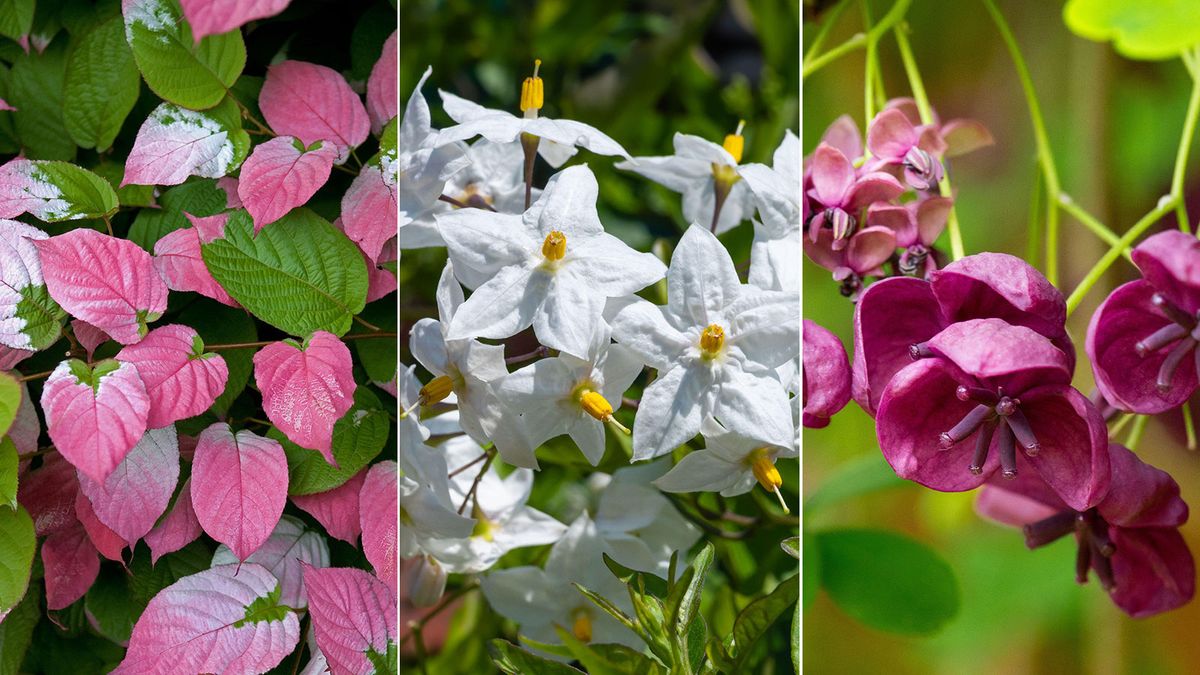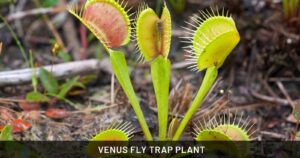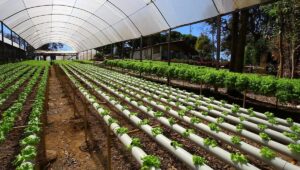Transform Your Landscape Quickly With These 12 Fast-Growing Vines
Creating vertical interest in your garden doesn’t have to take years. Fast-growing vines can transform bare walls, unsightly fences, or neglected pergolas into lush, vibrant features in a single growing season. Whether you’re looking for flowering options, decorative foliage, or evergreen privacy screens, the right vine can dramatically enhance your outdoor space while solving common landscape challenges.
Why Choose Fast-Growing Vines?
Fast-growing vines offer numerous benefits for impatient gardeners and practical landscapers alike. These vigorous climbers can quickly cover vertical surfaces, providing shade, privacy, and visual interest in a fraction of the time required by trees or shrubs. They’re perfect for:
- Disguising eyesores like chain-link fences or utility boxes
- Creating seasonal shade over patios and pergolas
- Establishing privacy screens between properties
- Adding vertical color to small gardens with limited ground space
- Reducing cooling costs when grown on sun-exposed walls
- Preventing soil erosion on slopes and banks
Fast-Growing Flowering Vines
Nothing transforms a landscape faster than flowering vines with their abundant blooms and often intoxicating fragrances. These varieties combine rapid growth with show-stopping displays.
Morning Glory (Ipomoea purpurea)
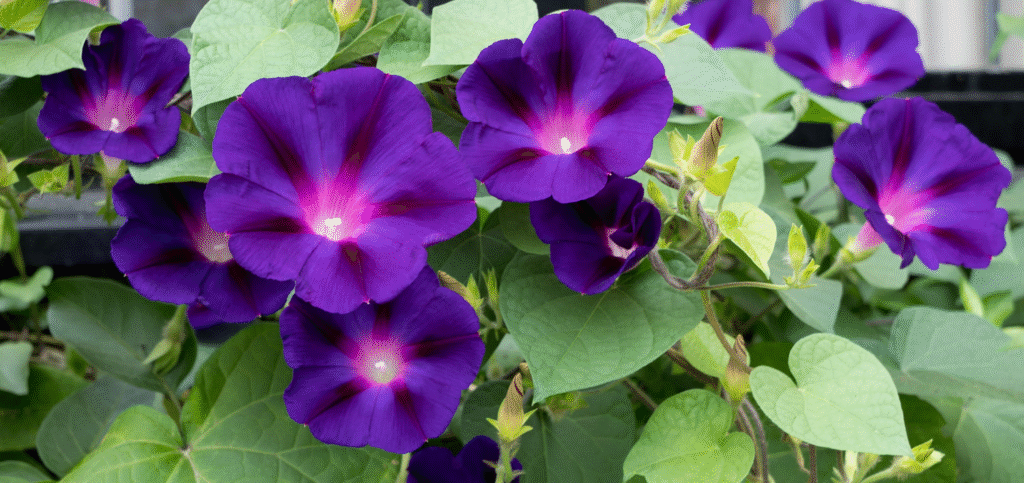
Growth Rate: Up to 10 feet in one season Hardiness Zones: Annual in most regions, perennial in zones 10-11
Morning glories are among the fastest-growing annual vines available, climbing quickly with their twining stems. Their trumpet-shaped flowers in shades of blue, purple, pink, and white open each morning and close by afternoon. Perfect for quick seasonal coverage, these vines self-seed readily. They prefer full sun locations and average, well-drained soil.
Expert Tip: To encourage faster germination, nick the hard seed coat and soak overnight before planting.
Clematis (Clematis spp.)

Growth Rate: 8-12 feet per season for vigorous varieties Hardiness Zones: 4-9 (varies by species)
While not all clematis are rapid growers, varieties like Sweet Autumn clematis (Clematis terniflora) and Clematis montana can grow 20+ feet in a single season under ideal conditions. These vines produce masses of star-shaped flowers in colors ranging from white to deep purple. Plant with “feet in the shade, head in the sun” for best results.
Warning: Some varieties can become invasive in certain regions. Check local recommendations before planting Sweet Autumn clematis.
Trumpet Vine (Campsis radicans)
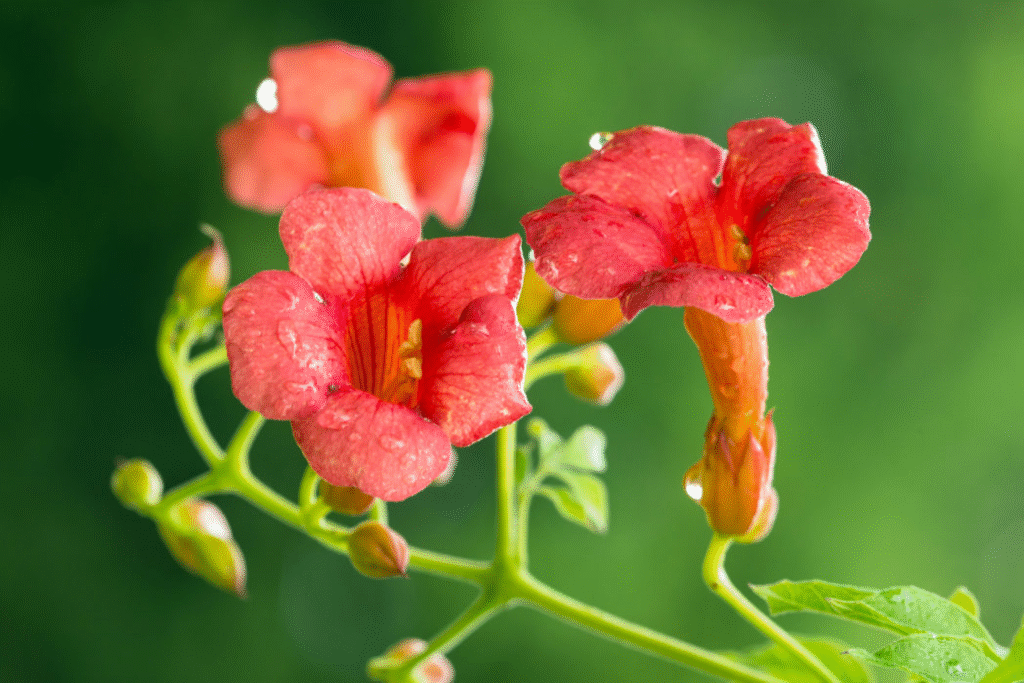
Growth Rate: 20-30 feet per season Hardiness Zones: 4-9
This North American native produces vibrant orange to red trumpet-shaped flowers that attract hummingbirds and butterflies. Trumpet vine climbs using aerial rootlets that cling to surfaces, requiring no additional support. While its aggressive growth makes it perfect for quick coverage, be prepared to manage its spreading tendency.
Maintenance Note: Plant in contained areas and remove suckers promptly to prevent unwanted spread.
Wisteria (Wisteria floribunda, W. sinensis)

Growth Rate: 10-15 feet per year once established Hardiness Zones: 5-9
Few vines create more drama than wisteria with its pendant clusters of fragrant purple, blue, or white flowers. American wisteria (W. frutescens) grows somewhat slower but is less aggressive than Asian varieties. These woody vines require sturdy support to handle their eventual weight.
Planting Tip: Choose American wisteria (W. frutescens) for more controlled growth and reliable flowering in cooler regions.
Fast-Growing Decorative Vines
These vines are prized more for their foliage than flowers, offering textural interest and consistent coverage.
Boston Ivy (Parthenocissus tricuspidata)

Growth Rate: 6-10 feet per year Hardiness Zones: 4-8
This self-clinging vine is renowned for covering the walls of prestigious universities. Its glossy green leaves turn brilliant red in fall, creating spectacular seasonal interest. Boston ivy attaches directly to surfaces with adhesive discs, requiring no trellis or support system.
Design Application: Ideal for brick or stone walls where the dramatic fall color can be showcased.
Virginia Creeper (Parthenocissus quinquefolia)
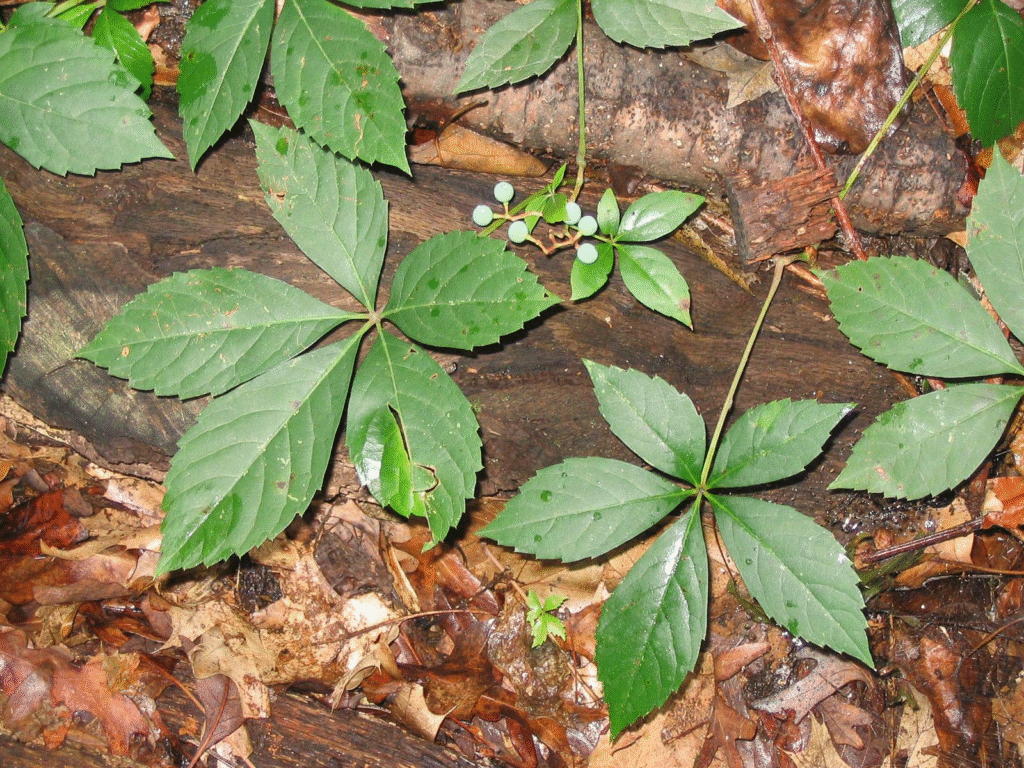
Growth Rate: 15-20 feet per season Hardiness Zones: 3-9
Another North American native, Virginia creeper features distinctive five-lobed leaves that transform from green to vibrant crimson in autumn. This adaptable vine thrives in sun or shade and tolerates poor soil conditions. Like Boston ivy, it climbs using adhesive pads that can damage mortar over time.
Ecological Benefit: Produces blue-black berries that provide valuable food for birds in fall and winter.
Silver Lace Vine (Fallopia baldschuanica)
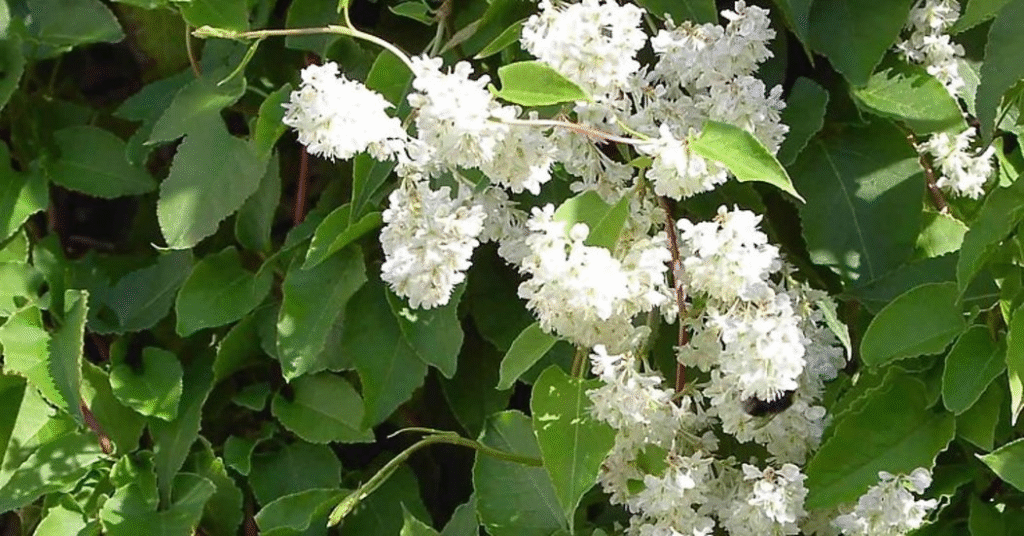
Growth Rate: 15-25 feet in one season Hardiness Zones: 4-8
This exceptionally fast grower produces clouds of small white to pinkish flowers in late summer through fall, creating a frothy, lace-like appearance. Its twining stems need support but can quickly cover arbors and pergolas.
Warning: Potentially invasive in some regions. Check local recommendations before planting.
Fastest-Growing Evergreen Vines
For year-round screening and structure, these evergreen options provide quick solutions with lasting presence.
English Ivy (Hedera helix)
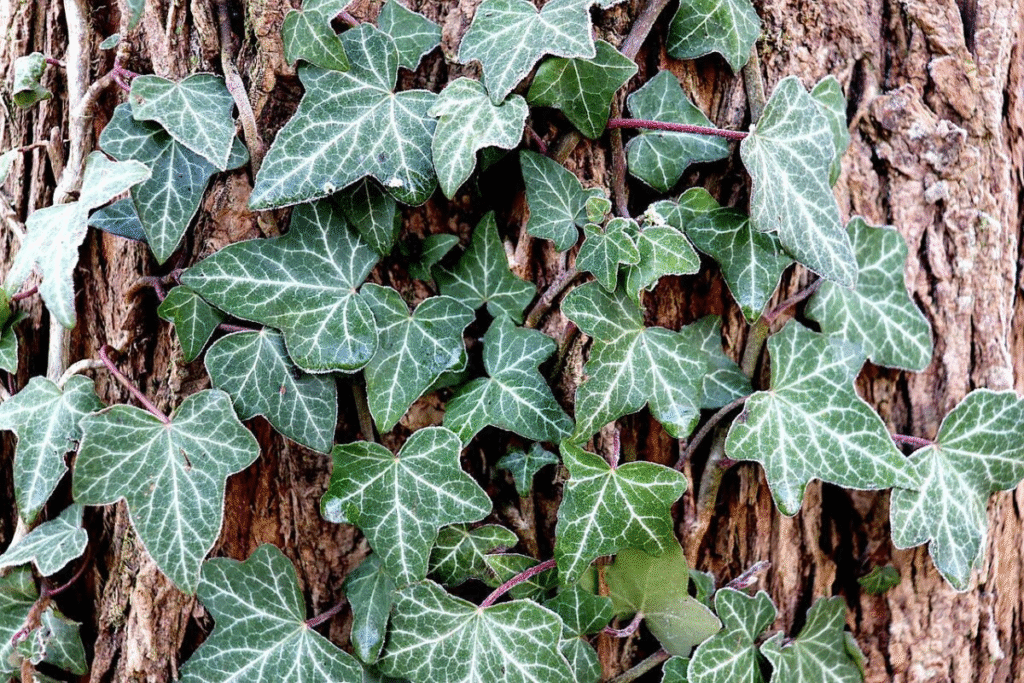
Growth Rate: 3-9 feet per year Hardiness Zones: 4-9
While slower than some deciduous options, English ivy is one of the fastest-growing evergreen vines, especially in shaded locations. Its glossy, lobed leaves provide year-round coverage and climb by aerial rootlets. Numerous cultivars offer variegated patterns and different leaf shapes.
Caution: Can be invasive in many regions, particularly in the Pacific Northwest and Southeast. Consider native alternatives where available.
Star Jasmine (Trachelospermum jasminoides)

Growth Rate: 3-6 feet per year Hardiness Zones: 8-10
Despite its common name, star jasmine isn’t a true jasmine but offers similar intensely fragrant white flowers in spring and summer. This versatile evergreen vine can be grown as a climbing vine, ground cover, or trailing plant. In warm climates, it maintains glossy green foliage year-round.
Uses: Perfect for fragrant coverage near patios, entryways, and outdoor living spaces.
Creeping Fig (Ficus pumila)
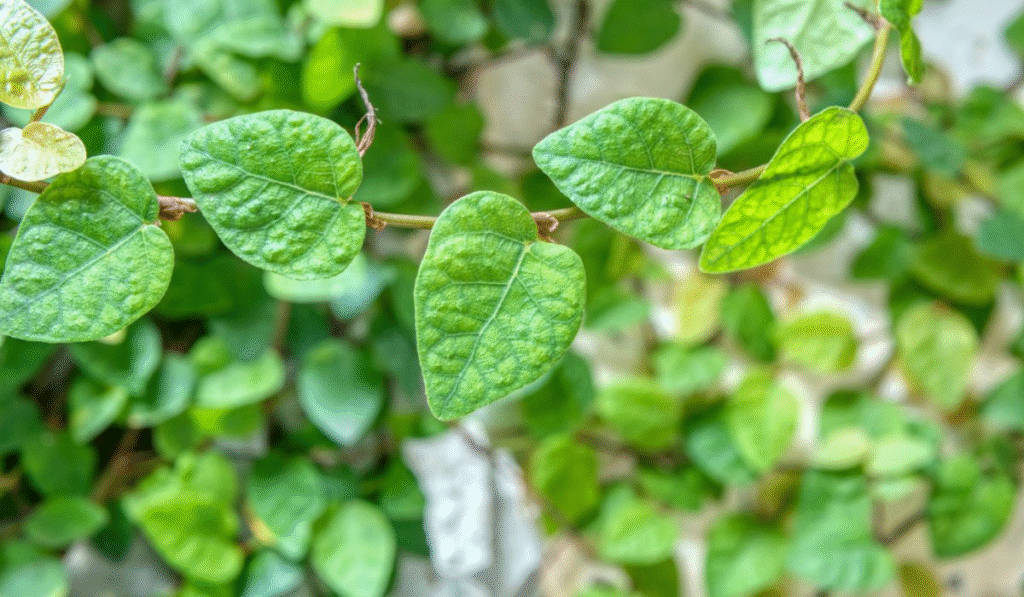
Growth Rate: 3-5 feet per year Hardiness Zones: 8-11
This diminutive-leaved vine creates a dense, tight covering on walls and structures. Its small, heart-shaped leaves create a textured green tapestry. Creeping fig attaches directly to surfaces with rootlets and requires no additional support.
Maintenance Note: Regular trimming keeps this vine in bounds and prevents it from developing larger, woody growth with maturity.
Fast-Growing Vines for Backyard Privacy
When you need quick screening solutions, these vigorous vines create living walls in minimal time.
Hops (Humulus lupulus)
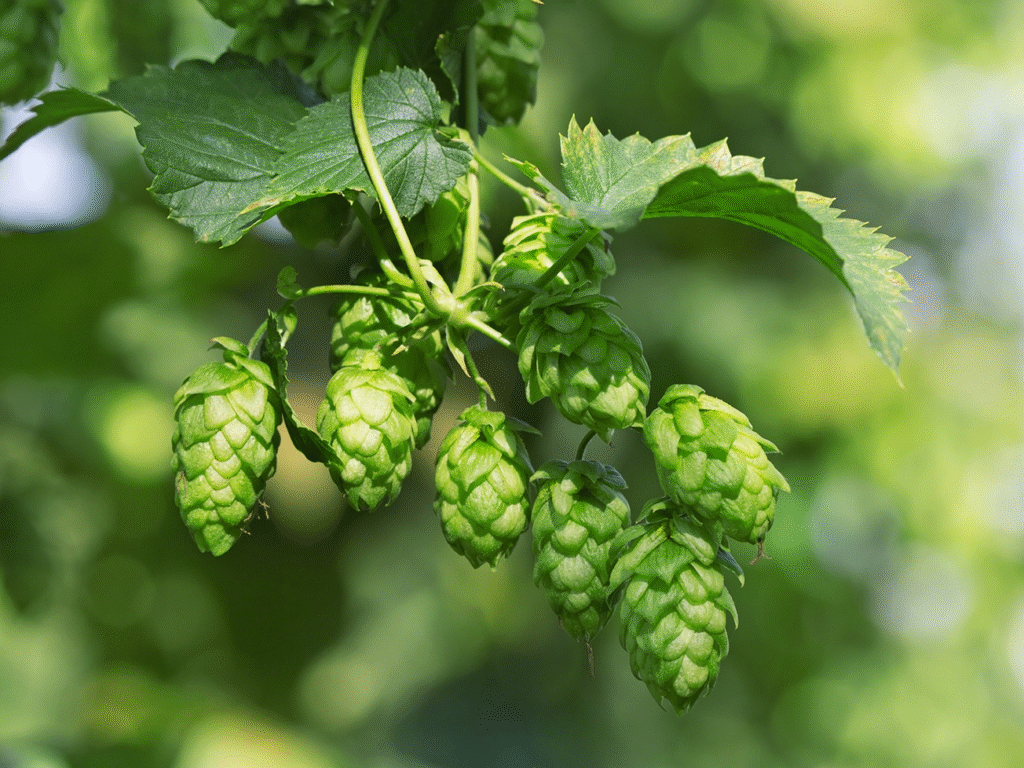
Growth Rate: 20-30 feet in a single season Hardiness Zones: 3-8
This herbaceous perennial vine dies back to the ground each winter but explodes with growth each spring. Beyond its use in brewing, hops creates excellent seasonal privacy with its large, textured leaves and interesting cone-like flowers. Grows best with strong vertical support.
Design Idea: Create a seasonal living wall by training on tensioned cable systems.
Passionflower (Passiflora incarnata)

Growth Rate: 15-20 feet per season Hardiness Zones: 6-10
The native American passionflower combines rapid growth with exotic blooms that seem almost tropical. Its intricate purple and white flowers yield edible orange fruits in late summer. This vine spreads by underground runners, so it can fill in privacy screens quickly.
Wildlife Value: Serves as host plant for several butterfly species, including the Gulf Fritillary.
How to Support Rapid Growth
To maximize the performance of fast-growing vines:
- Prepare soil thoroughly with compost and organic matter before planting
- Install appropriate support systems before plants become established
- Water consistently during establishment and dry periods
- Apply mulch to retain moisture and suppress competing weeds
- Fertilize moderately in spring with balanced organic fertilizer
- Prune strategically to direct growth and prevent unmanageable tangles
Common Mistakes with Fast-Growing Vines
Even experienced gardeners can be caught off-guard by vigorous vines:
- Underestimating mature size and strength
- Planting too close to structures without considering maintenance access
- Choosing inappropriate support that cannot handle the vine’s weight
- Neglecting regular maintenance, allowing vines to become overgrown
- Introducing potentially invasive species without containment plans
Environmental Considerations
When selecting fast-growing vines, consider their ecological impact:
- Choose native species when possible for better wildlife support
- Research invasive potential in your specific region
- Consider whether the vine provides food or habitat for beneficial insects and birds
- Be aware of vines that may damage trees if allowed to climb them
- Plan for appropriate containment if selecting vigorous non-native species
Seasonal Planning Guide
Spring
- Install support structures
- Plant new vines after danger of frost has passed
- Prune established vines before new growth begins
- Apply balanced organic fertilizer
Summer
- Train new growth in desired directions
- Monitor water needs during dry periods
- Control unwanted spreading
- Deadhead spent flowers on some varieties to encourage reblooming
Fall
- Enjoy fall color on deciduous varieties
- Apply light mulch around roots for winter protection
- Cut back dead growth on perennial varieties as needed
Winter
- Prune deciduous vines when dormant
- Plan for new installations
- Repair or replace support structures
- Order seeds for annual vines
Fast-growing vines deliver dramatic results with minimal waiting, making them perfect solutions for impatient gardeners and challenging landscape problems. By selecting the right variety for your climate, needs, and garden style, you can enjoy transformed outdoor spaces in just one growing season.
